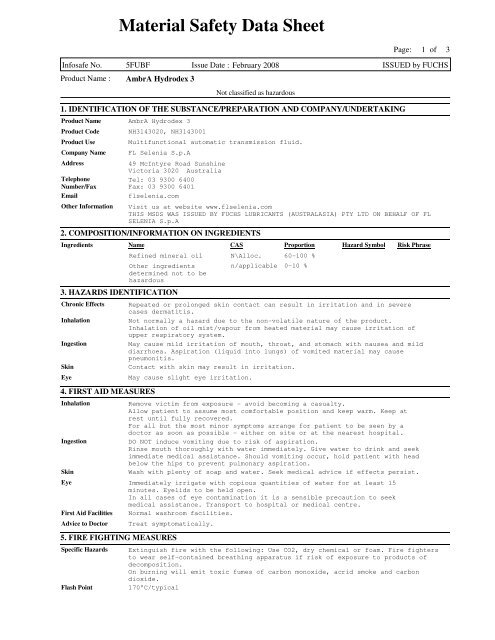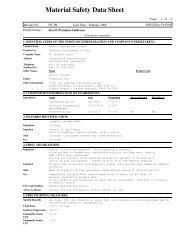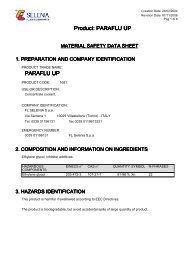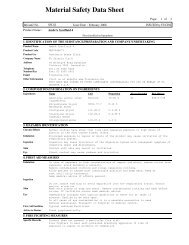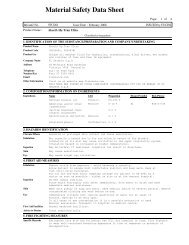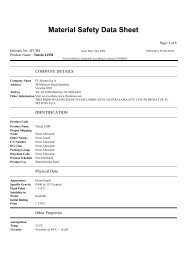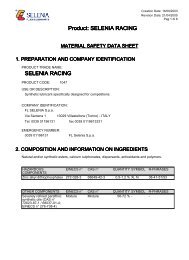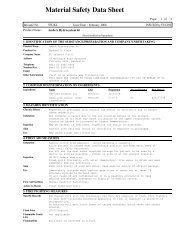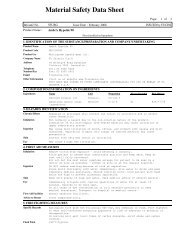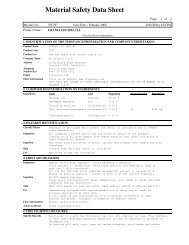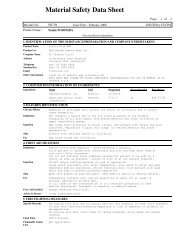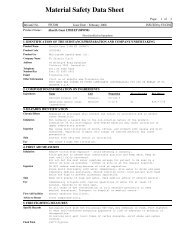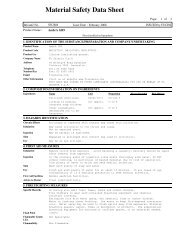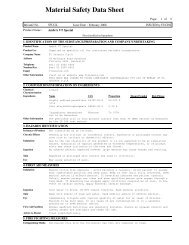Ambra Hydrodex 3 - FL Selenia
Ambra Hydrodex 3 - FL Selenia
Ambra Hydrodex 3 - FL Selenia
- No tags were found...
Create successful ePaper yourself
Turn your PDF publications into a flip-book with our unique Google optimized e-Paper software.
Material Safety Data SheetPage: 1 ofInfosafe No. 5FUBF Issue Date : February 2008 ISSUED by FUCHSProduct Name :AmbrA <strong>Hydrodex</strong> 3Not classified as hazardous1. IDENTIFICATION OF THE SUBSTANCE/PREPARATION AND COMPANY/UNDERTAKINGProduct Name AmbrA <strong>Hydrodex</strong> 3Product CodeProduct UseCompany NameAddressTelephoneNumber/FaxEmailOther InformationNH3143020, NH3143001Multifunctional automatic transmission fluid.<strong>FL</strong> <strong>Selenia</strong> S.p.A49 McIntyre Road SunshineVictoria 3020 AustraliaTel: 03 9300 6400Fax: 03 9300 6401flselenia.comVisit us at website www.flselenia.comTHIS MSDS WAS ISSUED BY FUCHS LUBRICANTS (AUSTRALASIA) PTY LTD ON BEHALF OF <strong>FL</strong>SELENIA S.p.A2. COMPOSITION/INFORMATION ON INGREDIENTSIngredientsName CAS Proportion Hazard Symbol Risk PhraseRefined mineral oilOther ingredientsdetermined not to behazardous3. HAZARDS IDENTIFICATIONChronic EffectsInhalationIngestionSkinEye4. FIRST AID MEASURESInhalationIngestionSkinN\Alloc.n/applicable60-100 %0-10 %Repeated or prolonged skin contact can result in irritation and in severecases dermatitis.Not normally a hazard due to the non-volatile nature of the product.Inhalation of oil mist/vapour from heated material may cause irritation ofupper respiratory system.May cause mild irritation of mouth, throat, and stomach with nausea and milddiarrhoea. Aspiration (liquid into lungs) of vomited material may causepneumonitis.Contact with skin may result in irritation.May cause slight eye irritation.Remove victim from exposure - avoid becoming a casualty.Allow patient to assume most comfortable position and keep warm. Keep atrest until fully recovered.For all but the most minor symptoms arrange for patient to be seen by adoctor as soon as possible - either on site or at the nearest hospital.DO NOT induce vomiting due to risk of aspiration.Rinse mouth thoroughly with water immediately. Give water to drink and seekimmediate medical assistance. Should vomiting occur, hold patient with headbelow the hips to prevent pulmonary aspiration.Wash with plenty of soap and water. Seek medical advice if effects persist.Eye Immediately irrigate with copious quantities of water for at least 15minutes. Eyelids to be held open.In all cases of eye contamination it is a sensible precaution to seekmedical assistance. Transport to hospital or medical centre.First Aid Facilities Normal washroom facilities.Advice to DoctorTreat symptomatically.5. FIRE FIGHTING MEASURESSpecific HazardsFlash PointExtinguish fire with the following: Use CO2, dry chemical or foam. Fire fightersto wear self-contained breathing apparatus if risk of exposure to products ofdecomposition.On burning will emit toxic fumes of carbon monoxide, acrid smoke and carbondioxide.170°C/typical3
Material Safety Data SheetPage: 2 ofInfosafe No. 5FUBF Issue Date : February 2008 ISSUED by FUCHSProduct Name :Flammable LimitsLELFlammabilityExplosion DataAmbrA <strong>Hydrodex</strong> 3Not applicableWill burn if involved in a fire.Not applicable6. ACCIDENTAL RELEASE MEASURESSpills & Disposal7. HANDLING AND STORAGEAdditionalinformation onprecautions for usePackagingNot classified as hazardousContain - prevent contamination of drains and waterways.Use absorbent (soil or sand, sawdust, inert material, vermiculite).Collect and seal in properly labelled drums for disposal.Dispose of waste as per Local, State and Federal Land Waste ManagementAuthorities. (Victoria:MMBW (03) 9615 6099)Observe standard safety precautions and good work practices. Do notcontinue to use contaminated clothingNo special packaging or labelling requirements.8. EXPOSURE CONTROLS/PERSONAL PROTECTIONNational ExposureStandardsPersonal ProtectiveEquipmentEng. ControlsNo value assigned for this specific material by the National OccupationalHealth and Safety Commission (WSA). Maintain exposure to a minimum.For oil mist, mineral: TLV TWA: 5mg/m3; STEL 10mg/m3Overalls, safety glasses and impervious gloves, eg. PVC.Avoid skin and eye contact, and inhalation of mists/aerosols.Wash contaminated clothing and protective equipment before storing/re-using.Avoid carrying contaminated rags in pockets or wearing of soaked clothing.If risk of inhalation of spray mist exists, wear combined organicvapour/particulate respirator meeting the requirements of AS1715 and AS1716.If using a respirator ensure that the cartridges are correct for thepotential air contamination and are in good working order.Maintain concentration below recommended exposure limit.If risk of overexposure exists, wear SAA approved respirator.9. PHYSICAL AND CHEMICAL PROPERTIESAppearanceRed liquid.Boiling Point > 316°CSpecific Gravity 0.87 @ 15°C/typical(H2O=1)Vapour Pressure < 0.1 mmHg @ 25°CVolatile ComponentFlash PointFlammabilityFlammable LimitsLELExplosion PropertiesOther InformationNone170°C/typicalWill burn if involved in a fire.Not applicableNot applicable10. STABILITY AND REACTIVITYHazardous ReactionSolubility in water: Not miscible.* Typical values only - Consult product information sheet.Store away from strong oxidizing or combustible materials.11. TOXICOLOGICAL INFORMATIONToxicologyInformationInhalationIngestionThis product is considered to be non-hazardous when used in accordance withgood industrial hygiene and the manufacturers recommendations.Not normally a hazard due to the non-volatile nature of the product.Inhalation of oil mist/vapour from heated material may cause irritation ofupper respiratory system.May cause mild irritation of mouth, throat, and stomach with nausea and milddiarrhoea. Aspiration (liquid into lungs) of vomited material may cause3
Material Safety Data SheetPage: 3 ofInfosafe No. 5FUBF Issue Date : February 2008 ISSUED by FUCHSProduct Name :SkinEyeChronic EffectsAmbrA <strong>Hydrodex</strong> 312. ECOLOGICAL INFORMATIONEnviron. ProtectionNot classified as hazardouspneumonitis.Contact with skin may result in irritation.May cause slight eye irritation.Repeated or prolonged skin contact can result in irritation and in severecases dermatitis.Non-biodegradable.Avoid contaminating waterways.13. DISPOSAL CONSIDERATIONS14. TRANSPORT INFORMATIONStorage andTransport15. REGULATORY INFORMATIONPoisons SchedulePackaging &LabellingStore in cool place and out of direct sunlight.Protect containers against physical damage and check regularly for leaks.Do not store in open or unlabelled containers. Store away from oxidizingagents or combustible material.Not Scheduled16. OTHER INFORMATIONNo special packaging or labelling requirements.Contact Person/Point Laboratory Manager (03) 9300 6400Research & Development Chemist (03) 9300 6400This information was prepared in good faith from the best information available atthe time of issue. It is based on the present level of research and to this extentwe believe it is accurate. However, no guarantee of accuracy is made or impliedand since conditions of use are beyond our control, all information relevant tousage is offered without warranty. The manufacturer will not be held responsiblefor any unauthorosed use of this information or for any modified or alteredversions.If you are an employer it is your duty to tell your employees, and any others thatmay be affected, of any hazards described in this sheet and of any precautionsthat should be taken.Material Safety Data Sheets are updated frequently. Please ensure you have acurrent copy.References Commonwealth of Australia,'Australian Code for the Transport of DangerousGoods by Road and Rail' AGPS (1998) 6th editionPoisons Schedule Not Scheduled...End Of MSDS...3


